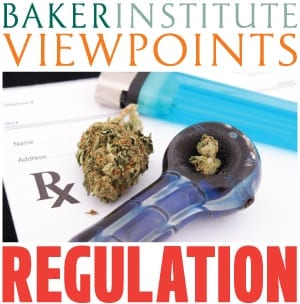Gary J. Hale, the nonresident fellow in drug policy at the Baker Institute, authors the second of a three-part Baker Institute Viewpoints series on the regulatory framework for legalized marijuana. Hale is the former chief of intelligence for the Houston Field Division of the Drug Enforcement Administration.
More from this series:
- “A bold new path: Moving beyond prohibition in Colorado and Washington,” by guest writer Tom Heddleston, Ph.D.
- “Optimal marijuana regulation,” by Nathan Jones, Baker Institute Alfred C. Glassell III Postdoctoral Fellow in Drug Policy
The best manner by which to deal with the issue of legal marijuana is to provide context to the meaning of “legal.” The “legality” of marijuana must be addressed in terms that define the movement of the drug from the source to the street, or in this case, from the land to the lip.
In the case of persons who choose to become wholesalers of the drug, and there will be many, there is a business model that will be followed to commercialize the production, transportation, sale and profits made from marijuana. First, the plant had to be cultivated, then, in some cases moved from its place of origin to market for distribution. As a result, new rules, regulations and/or laws will have to take into account the profits that will be generated from the sale of marijuana. The difference between whether an individual becomes a wholesaler, or is characterized as a personal user, will determine whether the federal government steps in to enforce laws that several states have chosen to liberalize through legislative change, or whether the federal government decides to not enforce the laws at all.
That is to say that while the federal government may look the other way when it comes to the possession and consumption of personal-use quantities, the U.S. attorney general could rightfully order the Drug Enforcement Administration and other federal law enforcement agencies to enforce the Controlled Substances Act when it is found that marijuana wholesalers are attempting to blend their activities with those of individual cultivators or consumers, or to hide behind liberalized state laws. Wholesale marijuana sales would likely not be tolerated by the federal government, despite the spirit of the state laws that are intended to legalize the personal use of small amounts of marijuana.
Serious thought must be given to determining whether wholesale cultivation of marijuana qualifies to enjoy the liberties of legalization. There is a big difference between a person who grows a few plants in his backyard for individual consumption and a person who
cultivates a plantation or who imports bales of marijuana from outside the United States for the purpose of generating significant profits.
The states should take the initiative to develop a threshold for personal-use quantities. It must be remembered that federal law supersedes state law in regard to this question and that it is only by the good graces of the U.S. attorney general that the federal government has taken a back seat to state activism in legalizing marijuana.
It is also likely that the U.S. attorney general’s office is waiting to see what Congress does in the wake of state laws legalizing personal use of marijuana before it develops policy at the Department of Justice. Full legalization of the possession and use of user-quantities of marijuana will only be reached if and when the Congress changes marijuana from its current designation as a prohibited substance under Schedule I of the Controlled Substances Act.
Under federal law, Schedule I drugs are the only category of controlled substances that may not be prescribed by a physician. Under 21 U.S.C. § 812b, Schedule I drugs must meet three criteria: the drug or other substance has a high potential for abuse; the drug or other substance has no currently accepted medical use in treatment in the United States; and that it is not recognized for safe use under medical supervision.
Congress will have to carefully examine whether these criteria, as well as the definitions and application of verbiage such as “high potential for abuse,” and “no currently accepted medical use in treatment” and “lack of accepted safety for the use of the drug” are terms that have become obsolete, or overcome by events — or whether they still apply to marijuana as a drug when alcohol abuse could easily be defined with these same criteria. These definitions are certainly open for discussion by Congress, especially because they can easily be argued by both proponents and opponents of legalization, depending on which side of the debate they may take.
Therefore, the best regulatory framework for the legalization of marijuana is one that clearly differentiates between user-quantities being cultivated and consumed by an individual, as opposed to wholesale commercial cultivation and sales activities being conducted by entrepreneurs that would otherwise be attempting to break federal laws — measures that are not intended to infringe on individual rights, but to preserve the safety and welfare of the public at large.
 Gary J. Hale is the nonresident fellow in drug policy at the Baker Institute. From 2000 to 2010, he was chief of intelligence in the Houston Field Division of the Drug Enforcement Administration. From 1990 to 1997, Hale had various assignments in Washington, D.C., including serving as chief of the Heroin Investigations Support Unit, chief of the Dangerous Drugs Intelligence Unit and liaison to the National Security Agency. During this period, he also served a tour of duty at the U.S. Embassy in Bogotá, Colombia. From 1997 to 1998, Hale was assigned as the DEA intelligence chief at the U.S. Embassy in Mexico City.
Gary J. Hale is the nonresident fellow in drug policy at the Baker Institute. From 2000 to 2010, he was chief of intelligence in the Houston Field Division of the Drug Enforcement Administration. From 1990 to 1997, Hale had various assignments in Washington, D.C., including serving as chief of the Heroin Investigations Support Unit, chief of the Dangerous Drugs Intelligence Unit and liaison to the National Security Agency. During this period, he also served a tour of duty at the U.S. Embassy in Bogotá, Colombia. From 1997 to 1998, Hale was assigned as the DEA intelligence chief at the U.S. Embassy in Mexico City.
